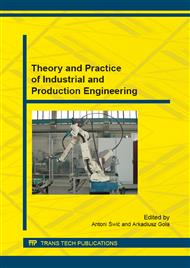p.141
p.146
p.153
p.161
p.166
p.174
p.178
p.184
p.189
Optimization of Selected Parameters of Modular Assembly Robot
Abstract:
An important task of designing the robotic assembly stand is to ensure the reliability and accuracy of the parts mating process. This can be achieved by selection of the appropriate method of assembling and by providing the required accuracy of the devices in the kinematic chain of assembly operation. Using high accuracy equipment and instrumentation leads to an increasing of the probability of correct realization of the process of parts mating, but this greatly increases the cost of assembly stand. The use of too precise and complex equipment to robotize the assembly process can be highly uneconomical. This paper presents a mathematical model that allows the selection of the parameters of the modular assembly robot performing the process of mating parts with flat and cylindrical surfaces, which represent the largest share among all the assembled parts. The presented model allows for the optimal selection of the accuracy of each robot modules which ensures reliable realization of assembly process without unnecessary increasing their accuracy, and therefore the stand cost. In the final part of the paper, the results of the model solution have been presented.
Info:
Periodical:
Pages:
166-173
Citation:
Online since:
September 2015
Authors:
Keywords:
Price:
Сopyright:
© 2015 Trans Tech Publications Ltd. All Rights Reserved
Share:
Citation:


